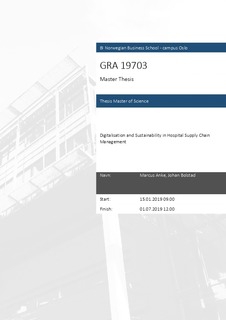Digitalisation and Sustainability in Hospital Supply Chain Management
Master thesis
Permanent lenke
http://hdl.handle.net/11250/2623584Utgivelsesdato
2019Metadata
Vis full innførselSamlinger
- Master of Science [1621]
Sammendrag
Purpose
Hospital supply chains are known to be complex entities dealing with a diversity
of products, patient needs and expectations from surroundings. They remain
fragmented and manual and have struggled to find an optimal structure to perform
excellent patient service. Stakeholders demand rapid information, high efficiency
and increased environmental awareness. There is a great potential for digitalised
improvements to develop hospitals to secure both present and future needs. The
purpose of this research has been to describe digitalisation and sustainability in a
hospital supply chain. Our goal is to explore how digitalised unmanned aerial
vehicles in hospital supply chain management can affect the three pillars of the
triple bottom line principle.
Methodology
We will use the reviewed literature to design a theoretical framework which will
be used as a base through this study. This theoretical framework will be applied to
a case study design for Oslo University Hospital. In this case study we will use a
mix of quantitative- and qualitative data, where latter is mainly obtained by semistructured
interviews.
Subject
Digitalised unmanned aerial vehicles used in a hospital supply chain to map the
sustainable effects. We are comparing the differences from a current and future
situation. Based on this, we have chosen our research question: “How can
digitalisation affect sustainability in a hospital supply chain management?”.
Key findings
The main finding was how digitalised unmanned aerial vehicles is a source to
predictability, which currently is absent in the hospital supply chain. Additionally,
abilities of digitalisation can enhance interaction and information sharing in the
hospital supply chain management. As a consequence, the flow of goods is
improved causing sustainable effects in all three pillars of the triple bottom line
principle. Definitions
Throughout the research we will use Oslo University Hospital (OUH) as the
designation of the hospital network of Oslo, including Rikshospitalet, Ullevål,
Aker Hospital, and all laboratories, clinics and facilities related to the hospital
network in Oslo.
We will also refer to Rikshospitalet several times in this research. When we refer
to Rikshospitalet we mean the specific hospital located at Gaustad in Oslo.
Furthermore, Ullevål Hospital (Ullevål) will be the specific hospital located in
Kirkeveien.
“Biological material” refers to several types of samples; blood samples, urine,
saliva, excrement, human tissue, semen, vaginal secretions, etc.
“Radioactive Isotopes (RI)” is a radioactive tracer used in Positron Emission
Tomography (PET) scans.
Beskrivelse
Masteroppgave(MSc) in Master of Science in Business, Logistics, operations and supply chain management - Handelshøyskolen BI, 2019
